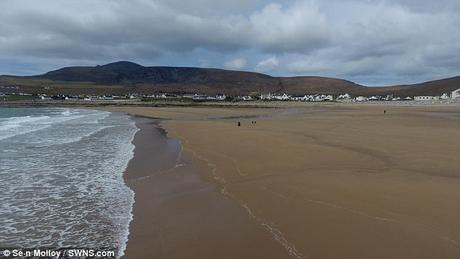 MailOnline reports that
the beach re-appeared miraculously
thanks to a freak tide, hundreds of thousands of tonnes of sand were dumped on
the beach over ten days in April, re-creating a stunning 300m long beach. The picturesque stretch is still in place,
with locals hoping it sticks around long enough for the beach to be given
blue-flag status during next year's inspection. A Tourism manager is quoted as
saying: 'Before it disappeared, the beach had been there for as long as living
memory, almost continuously, until 1984-85. 'During that time there was some
big storms that really destroyed the beach and it was completely washed away
and 1984 was the last time the beach was there. He said the bulk of the sand
was deposited in just over a week, leaving locals delighted and added that it
is so nice for the villagers to have
their beach back.
It is an incredible
example of the force and power of nature and how the coast can change in a
matter of days. With lots of people seeing the news, there is now plenty more
visitors. The article states that the beach
allegedly once vanished in the 1890s but returned within three decades. The beach used to be integral to the
population of Achill and during the 1845 famine, families moved to nearby to
live off the fish and rich soils. According to the history books, the beach at
Dooagh vanished in the 1890s but had returned within three decades, when a pier
was built in 1927. Back then, a bugle
would summon villagers to the beach when large amounts of wrack seaweed was
washed ashore with the spring tides.
MailOnline reports that
the beach re-appeared miraculously
thanks to a freak tide, hundreds of thousands of tonnes of sand were dumped on
the beach over ten days in April, re-creating a stunning 300m long beach. The picturesque stretch is still in place,
with locals hoping it sticks around long enough for the beach to be given
blue-flag status during next year's inspection. A Tourism manager is quoted as
saying: 'Before it disappeared, the beach had been there for as long as living
memory, almost continuously, until 1984-85. 'During that time there was some
big storms that really destroyed the beach and it was completely washed away
and 1984 was the last time the beach was there. He said the bulk of the sand
was deposited in just over a week, leaving locals delighted and added that it
is so nice for the villagers to have
their beach back.
It is an incredible
example of the force and power of nature and how the coast can change in a
matter of days. With lots of people seeing the news, there is now plenty more
visitors. The article states that the beach
allegedly once vanished in the 1890s but returned within three decades. The beach used to be integral to the
population of Achill and during the 1845 famine, families moved to nearby to
live off the fish and rich soils. According to the history books, the beach at
Dooagh vanished in the 1890s but had returned within three decades, when a pier
was built in 1927. Back then, a bugle
would summon villagers to the beach when large amounts of wrack seaweed was
washed ashore with the spring tides.
 Nature is all powerful and
unpredictable too. The strength of storm
and waves, change on decadal time-scales, and it is also possible that
environmental conditions have altered providing the ideal conditions for a
fresh build up of sand. It is also possible there has been a change in the
supply of sand, much further down the coast.
With regards – S.
Sampathkumar
Nature is all powerful and
unpredictable too. The strength of storm
and waves, change on decadal time-scales, and it is also possible that
environmental conditions have altered providing the ideal conditions for a
fresh build up of sand. It is also possible there has been a change in the
supply of sand, much further down the coast.
With regards – S.
Sampathkumar
7th May 2017.

